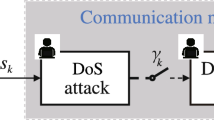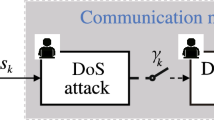Abstract
Traditional control does not pay much attention to information security problems in system identification enough, which are important in practical applications. This paper focuses on the security problem of input information in a class of system identification problems with noise and binary-valued observations, presents a cryptography based security protocol, and improves it in the range of allowed errors. During solving the identification problem, the improved security protocol can ensure that the input information is not leaked, and thus, can deal with passive attacks effectively. Besides, a quantitative relationship among the input information, the public key in encryption and the number of participants in the improved protocol is shown. Finally, the simulation results show that, the identification algorithm can still achieve the estimation accuracy by adding the improved security protocol. However, compared with the original identification algorithm, the time complexity of the algorithm with the improved security protocol increases.
Similar content being viewed by others
References
Wang D and Wang Y, Optimal military spending, trade and stochastic economic growth, Journal of Systems Science and Complexity, 2016, 29(3): 736–751.
Zhang L, Jin L, Luo W, et al., Robust secure transmission for multiuser MISO systems with probabilistic QoS constraints, Science China: Information Sciences, 2016, 59(2): 1–13.
Gordon L A and Loeb M P, The economics of information security investment, Journal ACM Transactions on Information and System Security (TISSEC), 2002, 5(4): 438–457.
Catteddu D, Cloud computing: Benefits, risks and recommendations for information security, Communications in Computer and Information Science, 2010, 72: 17–17.
Bulgurcu B, Cavusoglu H, and Benbasat I, Information security policy compliance: An empirical study of rationality-based beliefs and information security awareness, Journal MIS Quarterly, 2010, 34(3): 523–548.
Li T, Fu M, Xie L, et al., Distributed consensus with limited communication data rate, IEEE Transactions on Automatic Control, 2011, 56(2): 279–292.
Cheng H and WongW S, Application of protocol sequences in wireless networked control systems, Proc. of the 33rd Chinese Control Conference, 2014, 5666–5671.
Ding K, Li Y, Quevedo D, et al., A multi-channel transmission schedule for remote state estimation under DoS attacks, Automatica, 2017, 78: 194–201.
Li Y, Quevedo D E, Dey S, et al., A game-theoretic approach to fake-acknowledgment attack on cyber-physical systems, IEEE Transactions on Signal and Information Processing over Networks, 2017, 3(1): 1–11.
Serjantov A and Sewell P, Passive attack analysis for connection-based anonymity systems, Lecture Notes in Computer Science, 2003, 2808: 116–131.
Hirt M and Maurer U, Player simulation and general adversary structures in perfect multiparty computation, Journal of Cryptology, 2000, 13(1): 31–60.
Zhang Z, Privacy preserving cooperative solving system of linear equations, ChinaCrypt, 2007, 217–224.
Paillier P, Public-key cryptosystems based on discrete logarithms residues, Eurocrypt’99, Lecture Notes in Computer Science 1592, Springer-Verlag, 1999, 223–238.
Gentry C, Fully homomorphic encryption using ideal lattices, STOC, 2009, 169–178.
Author information
Authors and Affiliations
Corresponding author
Additional information
This research was supported by the National Key Basic Research Program of China (973 Program) under Grant No. 2014CB845301 and the National Natural Science Foundation of China under Grant No. 61227902.
This paper was recommended for publication by Editor SUN Jian.
Rights and permissions
About this article
Cite this article
Xu, C., Zhao, Y. & Zhang, JF. Information Security Protocol Based System Identification with Binary-Valued Observations. J Syst Sci Complex 31, 946–963 (2018). https://doi.org/10.1007/s11424-017-7075-7
Received:
Revised:
Published:
Issue Date:
DOI: https://doi.org/10.1007/s11424-017-7075-7




